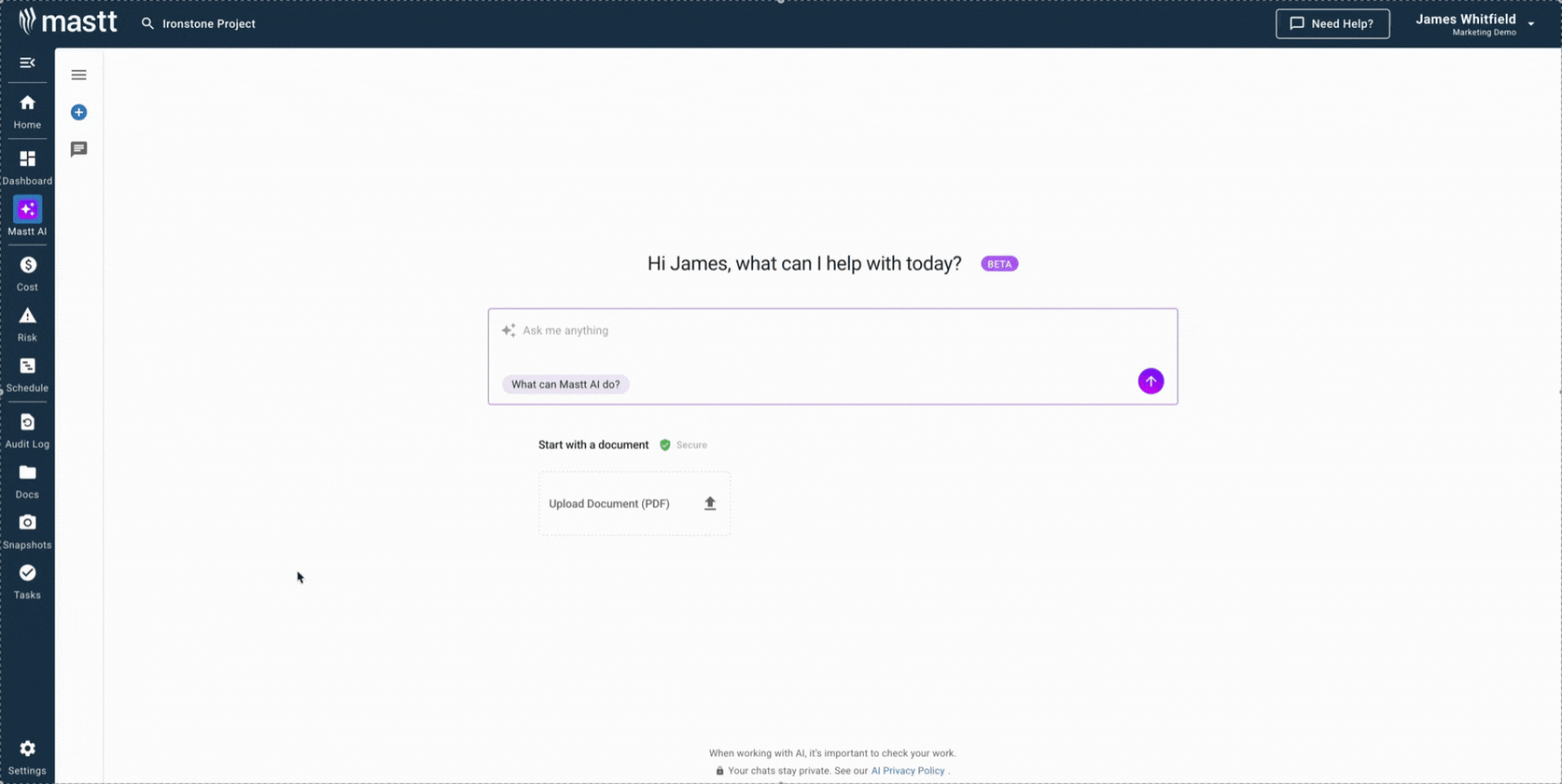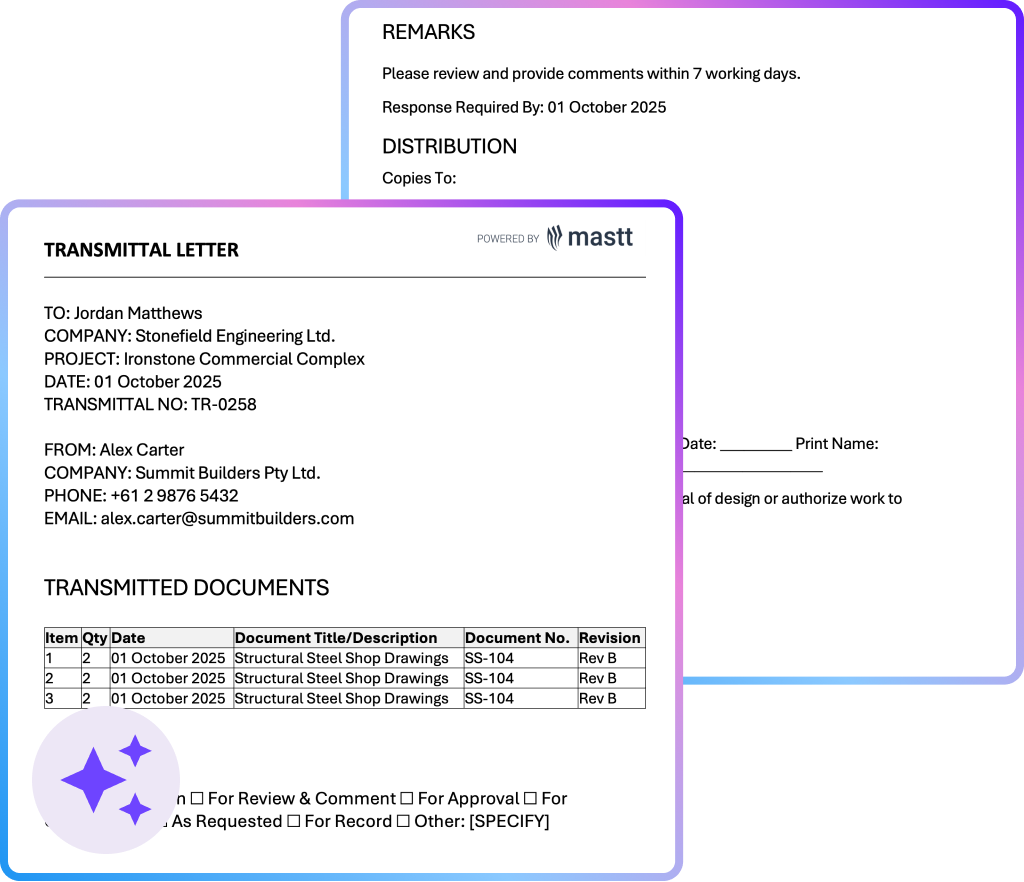What is a Transmittal Letter Template?
A transmittal letter template is a structured document format that accompanies construction drawings, specifications, reports, or other project materials being sent between parties in a construction project. It provides essential details about the enclosed documents, including revision numbers, purposes, and required actions from recipients.
Transmittal letters create an official paper trail that protects all parties by documenting what was sent, when it was sent, and what response is expected. These letters serve as legal evidence of communication, helping prevent disputes over document delivery and receipt.
What's Included in a Construction Transmittal Template
A comprehensive transmittal letter contains standardized fields that ensure consistent communication across all project stakeholders. It also includes sender and recipient information, project details, document descriptions, and action requirements.
A standard letter of transmittal template for construction includes:
- Project information: Identifies the project by name, contract number, and reference details.
- Sender details: States the name, company, role, and contact information of the person submitting the documents.
- Recipient details: Records the name, company, role, and contact information of the person receiving the documents.
- Date and transmittal number: Provides a unique reference for accurate record-keeping and tracking.
- Subject line or description: Summarizes the purpose of the transmittal in a concise statement.
- List of attached documents: Specifies file names, drawing numbers, revision numbers, and short descriptions.
- Reason for transmittal: Explains why the documents are being sent, such as for review, approval, record, or distribution.
- Instructions or notes: Outlines any actions required from the recipient.
- Signature or authorization: Confirms responsibility and authenticity of the submission.
💡 Pro Tip: Always include revision numbers in the attachment list to avoid disputes over which version of a document was shared.
Why Use a Template for Transmittal Letters in Construction?
Using a construction transmittal template provides consistency, efficiency, and accuracy in documenting project communication. Instead of drafting from scratch, a ready-to-use template ensures that every letter contains all required details and follows a professional format.
Key reasons to use a template for transmittal letters include:
- Standardization: Creates a uniform format across all project teams, reducing confusion and ensuring everyone follows the same process.
- Time efficiency: Saves project managers and contractors from repeatedly creating letters, allowing them to focus more on managing actual project tasks.
- Error reduction: Minimizes the risk of missing critical information, such as drawing revisions, submission purpose, or recipient details.
- Traceability: Provides a clear record of when and why documents were exchanged, supporting audits and dispute resolution.
- Professional presentation: Enhances communication by showing a consistent, formal approach to document submissions.
- Ease of record-keeping: Makes it simpler to log and retrieve transmittals in registers or digital systems.
💡 Pro Tip: Save your transmittal letter template as a master file and reuse it for every submission. Standardizing the format not only saves time but also keeps your project records consistent and easy to manage.
Who Should Use a Letter of Transmittal Template?
A construction letter of transmittal template is helpful for anyone involved in managing or exchanging project documents. It ensures that every handover is properly recorded, reducing the risk of miscommunication and lost files.
Key stakeholders who benefit from using a transmittal letter include:
✅ Project owners: Keep a formal record of all submissions received from contractors and consultants.
✅ Project managers: Track document flow across multiple teams and maintain accountability for deadlines and approvals.
✅ Contractors and subcontractors: Provide clarity when sending drawings, RFIs, or reports, ensuring recipients understand the purpose of the documents.
✅ Consultants and engineers: Document the transfer of design files, technical specifications, and revisions in a professional format.
✅ Document controllers and administrators: Maintain an organized log of all correspondence, making retrieval easier during audits or disputes.
Assign one role, such as a document controller or project administrator, to manage transmittals. Centralizing responsibility ensures accuracy and prevents duplication across teams.
How to Use a Transmittal Letter Template
To use a construction transmittal letter template, begin by entering the project details in the header, including the project name, contract number, and unique transmittal number for tracking. Make sure the recipient’s information is correct, including name, role, and company, to prevent delivery errors or delays.
Follow these steps to complete a transmittal letter template for construction:
- Fill in the details: Provide the sender’s information, recipient details, date of issue, and any instructions related to the submission.
- Select reason for issue: Indicate the purpose of the submission, such as for review, approval, distribution, or information only.
- Specify response required: Clearly state if the recipient needs to reply, approve, or acknowledge the documents sent.
- Enter document details: List every document being transmitted with file names, drawing or reference numbers, revision numbers, and a short description.
- Add additional commentary: Include any special notes or clarifications that the recipient should be aware of before reviewing the attachments.
- Review and approve: Double-check the accuracy of all information and have the letter signed or authorized if required.
- Send the letter: Attach the transmittal letter to the corresponding documents and ensure secure delivery to the intended recipient.
- Keep records: Store a copy of the transmittal letter in the project register or document management system for future reference, audits, or dispute resolution.
Completing the document listing section carefully is crucial, as it eliminates confusion over which version of a file was sent and ensures all parties have the same reference point. A systematic approach to using transmittal letters supports smoother workflows and stronger accountability across the project.
Generate Tailored Transmittal Letters with Mastt AI
Mastt AI eliminates the repetitive work of formatting a letter of transmittal template in Word or searching for a free downloadable letter of transmittal template. In just a few clicks, Mastt AI creates a professional, ready-to-go transmittal letter tailored to your project and compliant with construction industry standards.
Here’s what you can do with Mastt AI right away:
📄 Generate transmittal letters in seconds: Simply describe what you need, and AI creates a structured template with project details, sender/recipient info, and document lists.
✏️ Customize to your project: Adjust fields such as purpose, response required, or document references directly in your private chat until the letter matches your requirements.
📂 Export in the format you need: Download your completed construction transmittal letter template in Word or Excel for immediate use and sharing with stakeholders.
🔒 Stay secure and compliant: Every template is created in your private workspace, ensuring sensitive project data never leaves your control.
Here’s how to get started with Mastt AI:
- Type your request: For example, “create a construction transmittal letter template”.
- Work with AI: Refine the draft until it fits your project scope, purpose, and document set.
- Export and share: Download the transmittal letter in your preferred format and send it along with your documents.
By combining speed, accuracy, and security, Mastt AI ensures every transmittal is professional and consistent across your project portfolio.
👉 Explore more in our Help Center and start creating transmittal letters with Mastt AI today.

When to Use a Construction Transmittal Letter
Use construction transmittal letters whenever sending formal project documents that require tracking, review, or approval from other parties. Critical timing includes design phase submissions, contractor shop drawing submissions, and final deliverable handovers.
Specific scenarios requiring transmittal letters:
- Submitting design drawings: When architects or consultants share new or revised drawings for review or approval.
- Transferring reports: For progress updates, inspection reports, or compliance documentation provided to project owners.
- Exchanging contracts or specifications: When legal or technical documents are distributed to contractors or subcontractors.
- Final handover: At project completion, when as-built drawings, warranties, and manuals are formally delivered.
Use a transmittal letter whenever you exchange critical project documents, even for informal updates. Consistent use builds a reliable paper trail that protects all parties and keeps the project running smoothly.
Common Problems with Free Downloadable Transmittal Letter Template in Word
Using a free downloadable transmittal letter for construction may seem convenient, but it often creates more problems than it solves. Transmittal templates in Word or PDFs are typically generic, leaving out important details needed for construction projects.
Some of the most common issues include:
⚠️ Incomplete structure: Letter of transmittal templates in Word often omit critical sections such as transmittal numbers, reasons for issue, or response requirements.
⚠️ Formatting inconsistencies: Transmittal letter templates in PDF cannot be easily edited, leading to messy layouts or manual errors when updates are required.
⚠️ Version control risks: Using static files, such as a Microsoft Word letter of transmittal template, makes it difficult to manage revisions or maintain a clear record across multiple submissions.
⚠️ Limited customization: A generic construction transmittal template rarely includes project-specific fields such as detailed attachment listings or compliance notes.
⚠️ Poor integration: A standalone letter of transmittal template for construction in Word or PDF does not integrate with document control systems, making it harder to track transmittals across large projects.
💡 Pro Tip: If you rely on Word or PDF templates, customize a master version with all the fields your project requires before reuse. This helps standardize communication and ensures no critical details are left out.
Professional Transmittal Letters in Seconds with Mastt AI
Managing document exchanges doesn’t need to rely on clunky Word files or static PDFs. With Mastt AI, you can generate a construction transmittal letter in seconds, customized with the fields your project actually needs.
Every letter is created securely in your private workspace, giving you confidence that every submission is professional, traceable, and compliant.
👉 Try Mastt AI today and simplify transmittal letters so your team can focus on delivery, not formatting.






.avif)


